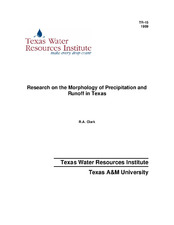Research on the Morphology of Precipitation and Runoff in Texas
| dc.creator | Clark, R.A. | |
| dc.date.accessioned | 2011-06-30T16:30:11Z | |
| dc.date.available | 2011-06-30T16:30:11Z | |
| dc.date.issued | 1969-02 | |
| dc.identifier.uri | https://hdl.handle.net/1969.1/94857 | |
| dc.description.abstract | This project has consisted of two distinct phases: (1) equipment modification and installation with associated collection and (2) analyses of data plus development of hydrologic techniques. Errors inherent in the utilization of radar as a hydrologic sensor are discussed. It is shown that errors in the measurement of in-cloud liquid water content can be as much as 100 per cent. Similar results will be obtained in the measurement of rainfall rates by weather radar. It is demonstrated that radar can be used quite effectively in the synthesis of hydrographs. In particular, the feasibility of using radar in streamflow forecasting has been tested for the Little Washita River in Oklahoma. The results were very encouraging. Techniques for hydrograph synthesis are discussed. These have been combined with a stochastic model (which incorporates a sixth-order Markov chain) for rainfall-runoff simulation. The proposed model has been tested thoroughly and appears to hold promise as a forecasting tool. A study was made of Hurricane Beulah which produced extremely heavy precipitation in south Texas and fostered an unprecedented number of tornadoes. The injection of dry air into the area northeast of the parent cyclone was apparently responsible for the extreme instability and development of a large number of tornadoes in that region. | en |
| dc.language.iso | en_US | |
| dc.publisher | Texas Water Resources Institute | |
| dc.relation.ispartofseries | TR;15 | |
| dc.title | Research on the Morphology of Precipitation and Runoff in Texas | en |
| dc.type | Technical Report | en |


